Key Takeaways:
- Checkbook covers provide security, organization, and personal style.
- To choose the perfect checkbook cover, consider functional features, material and design options, and customization.
- Maintain and care for your checkbook cover by cleaning it properly, protecting it against wear and tear, and replacing or upgrading it when needed.
- Alternative ways to organize finances include digitizing financial management, utilizing mobile banking apps, and adopting a personal finance system.
Welcome to the ultimate guide to checkbook covers! In today’s digital age, where online banking and mobile payments have become the norm, the humble checkbook may seem outdated. However, many individuals still rely on checks for various financial transactions, and protecting and organizing them effectively is essential. That’s where a checkbook cover comes in. This comprehensive guide will explore the importance of checkbook covers, how to choose the perfect one, how to maintain and care for them, and alternative ways to organize your finances.
The Importance of Checkbook Covers
Checkbook covers serve multiple purposes and offer various benefits, making them an essential accessory for anyone who uses checks regularly. Let’s delve into these benefits below:
1. Keeping Your Finances Secure
One of the primary reasons to invest in a checkbook cover is to keep your finances secure. Checks contain sensitive information, such as your bank account number and routing number, which can be exploited if they fall into the wrong hands. A good checkbook cover provides an extra layer of protection against theft, damage, and unauthorized access.
A secure checkbook cover will typically feature a sturdy outer material, such as leather or durable fabric, along with a secure closure mechanism, like a zipper or snap. These features ensure that your checks are safely tucked away and can’t be easily accessed or tampered with.
2. Enhancing Organization and Efficiency
Another crucial advantage of using a checkbook cover is that it helps enhance organization and efficiency in managing your finances. Without a proper cover, checks can become scattered or misplaced, leading to frustration and potential errors in your recordkeeping.
A checkbook cover typically includes slots or compartments to hold your checks and essentials, like a pen, cards, and a small notepad. This arrangement helps you keep everything you need in one place, making it easier to find and use your checks when required.
3. Making a Personal Statement
While functionality and security are essential, many view their checkbook cover as a personal accessory that reflects their style and personality. With a vast range of designs, colors, and materials, you can choose a checkbook cover that complements your unique taste.
Whether you prefer a sleek and professional look, a bold and vibrant design, or something that showcases your favorite hobbies or interests, there’s a checkbook cover to match your preferences. This personal touch can make even the most mundane financial tasks more enjoyable and stylish.
Choosing the Perfect Checkbook Cover
Now that we understand the importance of checkbook covers, let’s look at how to choose the perfect one. Consider the following factors when selecting a checkbook cover:
1. Functional Features to Consider
When evaluating a checkbook cover’s functional features, consider your specific needs and preferences. Consider factors such as the number of slots or compartments you require, the size of your checks, and if you want additional storage for cards or a notepad. Some checkbook covers even feature an ID window, allowing you to display your identification alongside your checks conveniently.
Additionally, pay attention to the closure mechanism. A secure closure, such as a zipper or snap, will ensure that your checks and other belongings remain in place and protected.
2. Material and Design Options
The material and design of a checkbook cover can greatly impact its durability, appearance, and overall feel. Common materials for checkbook covers include leather, faux leather, fabric, and nylon. Leather is known for its durability and classic look, while fabric and nylon options can offer a more casual or colorful style.
Consider the design elements that resonate with you. From simple and minimalistic designs to bold patterns or even personalized covers with monograms or unique artwork, there’s a wide variety of styles to choose from. Find a design that resonates with your personality and complements your individual style.
3. Customization for a Unique Touch
If you want to take personalization a step further, look for checkbook covers that offer customization options. Some manufacturers allow you to add your initials, name, or even a meaningful quote to the cover. Customization adds a unique touch and makes your checkbook cover easily identifiable.
Whether you add your name in an elegant script or opt for a playful monogram, customizing your checkbook cover can provide a sense of ownership and make it one-of-a-kind.
How to Maintain and Care for Your Checkbook Cover
Once you’ve chosen the perfect checkbook cover, it’s essential to know how to maintain and care for it to ensure its longevity and continued functionality. Here are some tips for keeping your checkbook cover in top condition:
1. Cleaning and Maintaining the Cover
Regular cleaning and maintenance can keep your checkbook cover looking its best. The specific cleaning instructions may vary depending on the material, so follow the manufacturer’s recommendations.
Use a mild soap or leather cleaner and a soft cloth to remove any dirt or stains from leather checkbook covers. Avoid using harsh chemicals or abrasive materials that can damage the leather. It’s also a good idea to apply a leather conditioner periodically to keep the material supple and prevent cracking.
For fabric or nylon checkbook covers, check the care label for instructions. A gentle hand wash or spot cleaning with a mild detergent should suffice. Air dry the cover to prevent shrinkage or damage from high heat.
2. Protecting Against Wear and Tear
While checkbook covers are designed to withstand everyday use, taking precautions to protect them from excessive wear and tear is essential. Avoid placing sharp objects or heavy items on your checkbook cover, which can cause scratches or damage.
When not in use, store your checkbook cover in a safe and dry place to prevent exposure to moisture or extreme temperatures. Excessive heat or humidity can warp the cover or degrade the material over time.
If your checkbook cover has a leather or fabric exterior, consider applying a water-repellent spray to protect against accidental spills or moisture.
3. Replacing or Upgrading Your Checkbook Cover
Despite proper care and maintenance, there may come a time when you need to replace or upgrade your checkbook cover. Over time, the cover may show signs of wear, such as frayed edges or faded colors, which can detract from its overall appearance.
If you decide to replace your checkbook cover, take the opportunity to reassess your needs and preferences. A different material, design, or additional feature would better suit your current lifestyle or taste.
Consider donating your old checkbook cover if it’s in good condition but no longer meets your needs. Many charitable organizations and thrift stores accept gently used items that can be repurposed or sold to support their causes.
Alternative Ways to Organize Your Finances
While checkbook covers are excellent for keeping your physical checks organized, exploring alternative ways to manage your finances is essential. Here are a few suggestions:
1. Digitize Your Financial Management
Digitizing your financial management can streamline your recordkeeping, simplify tracking expenses, and reduce clutter. Use personal finance software or apps to input and categorize expenses, create budgets, and generate reports.
Many financial management tools also offer mobile apps, allowing you to access your financial information conveniently. Ensure you choose a reputable and secure application to safeguard your sensitive data.
2. Utilize Mobile Banking Apps
If you prefer the convenience of mobile banking, use your bank’s mobile app. Most banking apps allow you to manage accounts, transfer funds, pay bills, and deposit checks using your smartphone camera.
Mobile banking apps provide real-time access to your account balances and transaction history, making it quick and convenient to stay on top of your finances. Remember to keep your mobile device secure by using passcodes or biometric authentication.
3. Adopt a Personal Finance System
Beyond digital tools, adopting a personal finance system can help you stay organized and achieve your financial goals. This system could involve setting up automatic bill payments, tracking your expenses meticulously, and regularly reviewing your financial progress.
Consider implementing strategies such as the envelope system, which allocates cash into envelopes for various expense categories. This method can provide a tangible way to control spending and budget effectively.
Another popular approach is the 50/30/20 rule, where you allocate 50% of your income to needs, 30% to wants, and 20% to savings or debt repayment. Following a system can structure your financial habits and help you make informed decisions about your money.
Remember, the key is to find a system that works for you and aligns with your goals and lifestyle.
With this comprehensive guide to checkbook covers, you now have the knowledge and tools to protect and organize your finances in style. Remember to choose a checkbook cover that suits your needs and personal style, maintain it properly, and explore alternative methods to manage your finances effectively. Implementing these tips ensures that your financial transactions are secure, organized, and hassle-free.
FAQ
Question: Why should I use a checkbook cover? – A checkbook cover provides security, organization, and personal style for your checks.
Question: How does a checkbook cover keep my finances secure? – A checkbook cover provides protection against theft, damage, and unauthorized access to your checks through features like sturdy materials and secure closure mechanisms.
Question: Can a checkbook cover help with organization? – Yes, a checkbook cover helps enhance organization by providing compartments to hold your checks and slots for essentials like a pen, cards, and notepad.
Question: Can I express my personal style with a checkbook cover? – Absolutely! Checkbook covers come in various designs, colors, and materials to match your unique taste and personality.
Question: What should I consider when choosing a checkbook cover? – Factors to consider include functional features like the number of compartments, material and design options, and customization availability.
Question: How should I clean and maintain my checkbook cover? – Cleaning instructions depend on the material but generally involve using mild soap or cleaners for leather covers and gentle hand washing for fabric or nylon covers.
Question: How can I protect my checkbook cover from wear and tear? – Avoid placing sharp objects or heavy items on your checkbook cover, store it in a safe and dry place when not in use, and consider applying a water-repellent spray for added protection.
Question: When should I replace or upgrade my checkbook cover? – Consider replacing your checkbook cover if it shows signs of wear or your needs and preferences have changed. You can donate your old cover if it’s still in good condition.













Comments